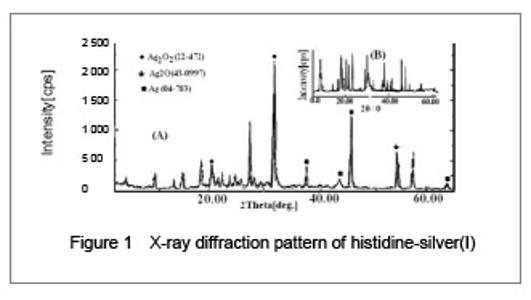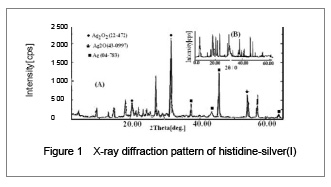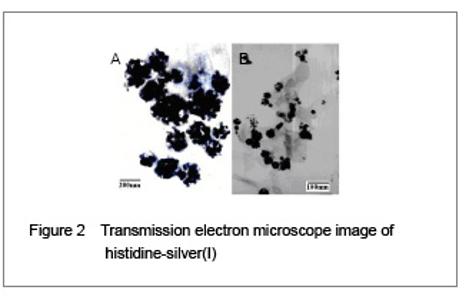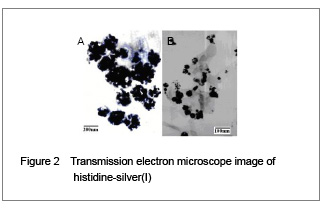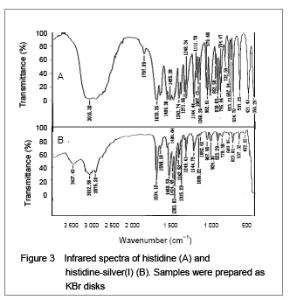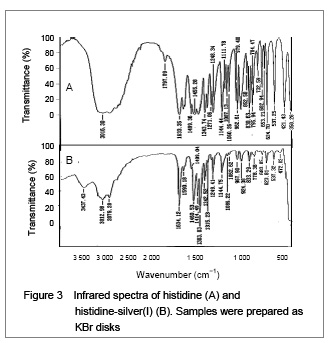| [1] Wigley RA, Brooks RR. Noble Metals and Biological systems. Boca Raton: CRC Press. 1992:277-297.[2] Stillman MJ, Presta A, Gui Z, et al. Spectroscopic studies of copper, silver and gold-metallothioneins. Met Based Drugs. 1994;1(5-6):375-393.[3] Zingel V, Leschke C, Schunack W. Developments in histamine H1-receptor agonists. Prog Drug Res. 1995;44: 49-85.[4] Yamaguchi T, Lindqvist O. The crystal structure of diammine silver nitrate, Ag(NH3)2NO3, at 223K. Acta Chem Scand. 1983;37(8):685-689.[5] Choi SH, Lee SH, Hwang YM, et al. Interaction between the surface of the silver nanoparticles prepared by γ-irradiation and organic molecules containing thiol group. Rad Phys Chem. 2003;67(3-4):517-521.[6] Li L, Zhang CP, Shen DJ. Preparation and characterization of polymeric ultrafine particles on Hb-SDS-Ag hydrogeles. Guang Pu Xue Yu Guang Pu Fen Xi. 2002;22(3):501-503.[7] Zhang CP, Zhang W. IR, Raman and UV/VIS spectroscopic studies on some proteins with silver(I)-copper(II) ion complexes. Huaxue Shiji. 1999;21(1):11-14.[8] Zhang CP, Xia M. The formation and spectra of the proteins-silver-copper complexes. Guang Pu Xue Yu Guang Pu Fen Xi. 1996;16(5):43-49.[9] You YH, Zhang CP. The photochemistry properties on interaction silver with tryptophan. Spectrochim Acta A Mol Biomol Spectrosc. 2008;69(3):939-946.[10] You YH, Zhang CP. Interaction between silver ions and histidine. Zhongguo Zuzhi Gongcheng Yanjiu yu Linchuang Kangfu. 2010;14(29):5498-5504.[11] Xiao ZD, Zhang CP, Shan DJ. The photochemistry properties on reaction of amino acids and silver. Yingxiang Kexue yu Guanghuaxue. 2005;23(3):209-217.[12] Hua JC. Microstructure Analysis of Polycrystalline X-ray Diffraction. Shanghai: Huadong Normal University Press. 1989:155-180.[13] Klug HP, Alexander LE. X-ray Diffraction Procedure for Polycrystalline and Amorphous Materials. New York: Wiley. 1974:652-660.[14] Bellamy LJ. The Infra-red Spectra of Complex Molecules. 3rd ed. London: Chapman and Hall. 1978.[15] Silverstein RM, Bassler GC, Morrill TC. Spectrometric Identification of Organic Compounds. 5th ed. New York: Wiley. 1991.[16] Fu JZ, Liu YY, Gu PY, et al. Spectroscopic charcterization on the biosorption and bioreduction of Ag(I) by Lactobacillus sp.A09*. Acta Phys Chim Sin. 2000;16(9): 779-782.[17] Zhou WJ, Wang Y, Wu JG, Eds. Modern Fourier-Transform Infrared Spectroscopy and Its Applications, Part (in Chinese). Beijing: Literature of Science and Technology Press. 1994:273-293.[18] Castro JL, Lopez Ramírez MR, Lopez Tocón I, et al. Vibrational study of the metal-adsorbate interaction of phenylacetic acid and α-phenylglycine on silver surfaces. J Coll Inter Sci. 2003;263(2):357-363.[19] Lu YQ, Deng ZH. The Practical Infrared Spectrum and Analyze. Beijing: Electron-industry Press. 1989:8. |
